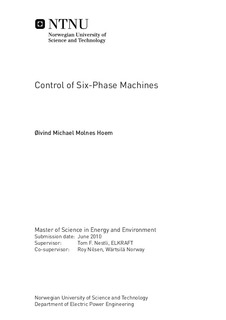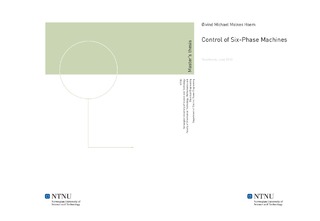| dc.description.abstract | The purpose of the work presented in this report was to continue the study of a six phase dual winding IPMSM with split dc-link conducted in [1]. The setup has been proposed as a means to improve the power ratings of ship-propulsion motors by increasing the number of stator windings, and thereby avoiding the problem of phase current limita-tions. The addition of a split dc-link gave the system increased redundancy and reliability by making the three phase inverter for each winding group capable of independently receiving power from separate sources.
The simulations performed in [1] showed unsatisfactory response in crucial fault situa-tions that directly influence the machines reliability and redundancy. In order to improve the systems response to these faults a new control structure proposed by [2], have been constructed to replace the Double Synchronous Frame Current Control (DSFC) used in [1]. This new control structure is named Decoupled Six-Phase Current Control (DSPC) and utilizes the rotating vector space decomposition, to be introduced later, in order to successfully control both the (d,q) and (z1,z2) subsystem. Classical dq current controllers were used to regulate both subsystems.
The work has focused on understanding, developing and comparing the control strategy for such a machine, by theoretical modelling, analysis and analogue simulations of the machine and control structure. The new decoupled control structure will be analyzed and compared to the results of the DSFC structure. The simulations were used to verify the machines ability to perform under normal operations, as well as its response to certain fault situations. Particular effort has been made to study the transient effects of asymmetric torque limitations and dc-link undervoltage on the system.
The simulations carried out showed that the new control structures ability to respond to changes in torque reference, during normal operation, were satisfactory. The control structure was able to quickly follow the torque reference and split the load evenly on the two inverters. This was done without excitation of the (z1,z2) subsystem.
The simulations of the system response to asymmetric torque limitations also gave sa-tisfactory results when including the decoupling elements for both subsystems. The di-rect and quadrature axis currents were rapidly regulated to their new steady state values for both inverters. This was done without considerable overshoot, and without en-dangering the integrity of the two inverters.
However, the system response to low dc-link voltage shows a need to implement addi-tional control features in order to make the system successfully respond to a low dc-link voltage. This is in particular true for the step in dc-link voltage, where a large initial cur-rent peak may cause the trip of the motor drive.
It should be stressed that these are the results of analogue simulations, not including the effect of a digital control structure and the disturbance introduced by inverter switching. | |

